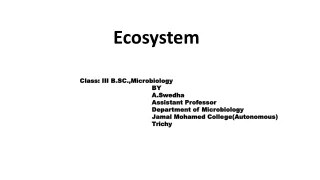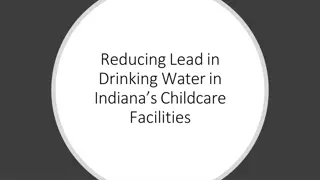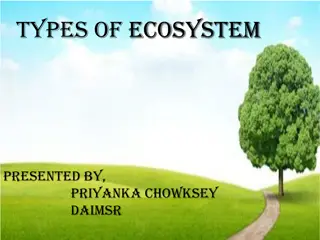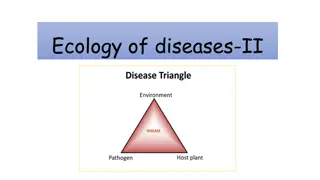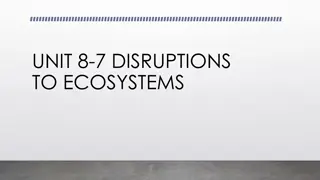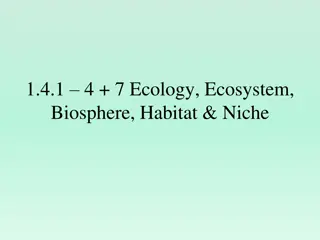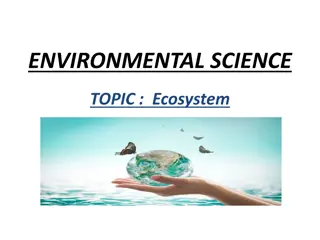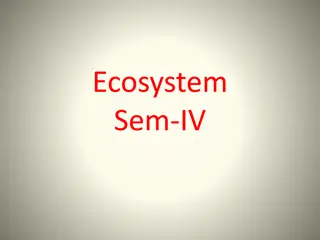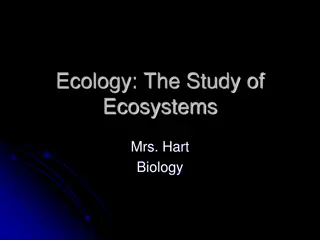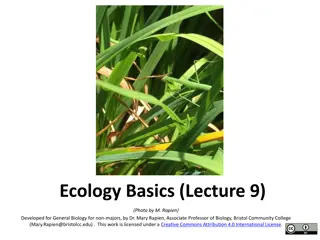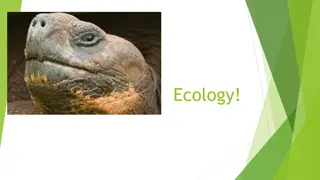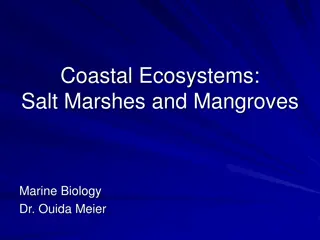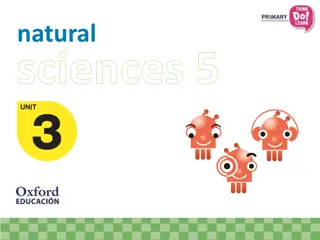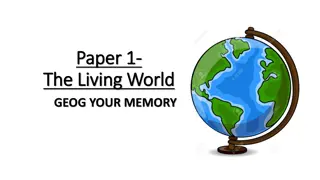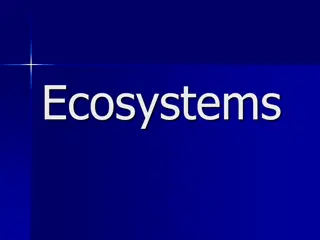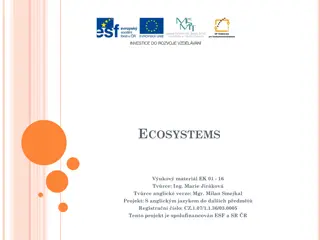
Impact of Human Activities on the Environment
Explore the significant impact of human activities on the environment due to technology advances and population growth. Learn about the need for global awareness, cooperation, and action to address ecological problems and ensure sustainable use of resources.
Download Presentation

Please find below an Image/Link to download the presentation.
The content on the website is provided AS IS for your information and personal use only. It may not be sold, licensed, or shared on other websites without obtaining consent from the author. If you encounter any issues during the download, it is possible that the publisher has removed the file from their server.
You are allowed to download the files provided on this website for personal or commercial use, subject to the condition that they are used lawfully. All files are the property of their respective owners.
The content on the website is provided AS IS for your information and personal use only. It may not be sold, licensed, or shared on other websites without obtaining consent from the author.
E N D
Presentation Transcript
All living things have an effect on the environment Example: Breaking twigs as you walk Normally effects are small Humans however have made a large impact on the environment In part due to our technology advances and our growing population. We need more resources and therefore are making larger changes in the environment Our decisions on how to use (or misuse) our resources will have a huge impact on the earth and it s organisms
Human activities can create ecological problems that must be avoided or corrected We need to become more environmentally literate People need to understand the cause and effect of our environmental actions and how to solve these problems Environmental issues often effect many countries Resolving these issues takes global awareness, cooperation, and action
Like all living things, humans are a part of the Earth s ecosystems We depend on the ecosystem for food, water, and air As long as our ecosystem functions normally, those essential resources will be available to us We can depend on the plants to provide us oxygen and recycle our carbon dioxide and for the quality of our water to stay stable
Earth has a finite supply of resources Some of our resources are renewable: food supply and solar energy Renewable resources are those, given sufficient time, will be replaced Nonrenewable resources are those that will never be replaced Example: fossil fuels, minerals The decisions we make today and tomorrow will determine whether or not we increase or decrease our use of resources To reduce; we can control the growth of our population
Although may resources are renewable, they must be used carefully Increased consumption can stress the natural process Resources may not be able to renew itself Example: fish are a renewable resource. After catching fish, with time the population of the fish would recover. However, current fishing methods can catch so many fish at once that the populations may not be able to reproduce quick enough
Our constant consumption of resources is becoming a serious problem Aluminum (we use for packaging) and silicon (we use for computer chips) are nonrenewable Fossil fuels (we use as gas) and coal (we use to power factories) are nonrenewable If we use too many nonrenewable resources, they will become depleted (serious reduction) within a relatively short time
We can maintain our renewable and nonrenewable resources by practicing the three R s Reduce Reuse Recycle The 3 R s Reduce The 3 R s Action Avoid using the resource Action Example Use energy efficiently; walk, bike, or carpool instead of driving Use dishes rather than paper plates. Instead of discarding a paper lunch bag, take it home and use it again Paper, metal, plastic and glass are all easily recycles. Donate unwanted clothing, books, and furniture to charitable Example Reuse Use the same produce over and over, instead of throwing it away after one use Recycle Don t throw it in the trash. Discard the produce in a way that it can be used again, or to make another product
Many natural processes can affect life and health of humans and other organisms Some activities of humans affect these processes, most of the changes can be detrimental (damaging) to the ecosystem Example: pollution (a harmful change in the chemical makeup of the soil, water, or air) is within a habitat, the organisms within that habitat will suffer The species that live there and the variety of those species may suffer
Throughout the biosphere, animals take in oxygen and release carbon dioxide; plants take in carbon dioxide and release oxygen The biotic processes of respiration and photosynthesis keep the levels of these gases in the atmosphere within a suitable range Abiotic factors help to maintain the quality of the atmosphere Example: rain falls and cleans the air of particles and soluble gases. Also helps maintain humidity
Soils form when weathering breaks down rocks and when organism materials from decaying plants and animals accumulate These soils support growth of producers and serve as a habitat for decomposers Root systems hold the soil in place If you removed the vegetation, the soil would be washed away by rain or blown away by wind Soil erosion can happen during a drought when the vegetation naturally dies
Water continually evaporates from the surface of land and leaves from plants Water vapor rises into the atmosphere and collects in clouds that can move long distances Eventually the vapor condenses and precipitates, distributing it over many areas on Earth Water collects as runoff or groundwater or evaporates This process = water cycle Many ecosystem maintain a supply of fresh water which is available to all organisms
Plants that live in the soil use the soils minerals as they grow Nutrients are transported from one organism to another through food chains in the ecosystem Those that are not transferred eventually return to the earth through decomposers (through death or wastes) Nutrients are then restored to the soil, where they can then be used by other plants, continuing the cycle
Without this recycling, much of the abiotic materials needed for life would remain locked up in the bodies of dead organisms They would not be available for new organisms In tropical rainforests, heavy rains are frequent, decomposition needs to recycle quickly. The frequent rain would strip the land of it s minerals before new plants could absorb it. In areas where the rainforest has been stripped, many of the nutrients have washed away and the land is now infertile Humans can take advantage of this when we compost. Compost is a natural fertilizer. Adding compost recycle wastes naturally and reduces the need for chemical fertilizers. Reduces the wastes in land fills/burned
Food chains, food webs, and energy pyramids show the flow of energy Each organism has a role and contributes the overall stability of the ecosystem Losing any member of that ecosystem can upset the stability of the entire ecosystem Energy is passed through the environment but it is not recycled. A lot of energy is lost through heat This cannot be recaptured Ecosystems need a constant source of energy = sun
Because humans are part of the earths ecosystem, they affect the way the ecosystem works We affect changes in the ecosystem Once an ecosystem is damaged, people may suffer the damage just like any other species
Most species in the environment can have a period of rapid population growth The population increase levels off as it approaches the ecosystems carrying capacity (number of species an ecosystem can support) Example: There is a boom of rabbits, eventually food dwindles and the population growth levels off The growth of the rabbits are balanced by limiting factors (food, predators, disease)
The Earth has a carrying capacity for humans as well The more people there are, the more resource we need and more waste is produced. Overcrowding and lack of food becomes a problem when the population grows For thousands of years the human population grew slowly 300 years ago, with improvements in heath care, hygiene, and food supply there was a dramatic increase. It is growing so rapidly, we will hit carrying capacity soon. Food, water, space, and oxygen will become limited creating famine, disease, wars over resources which will decrease our population size for us
Some human activities that destroy habitats and ecosystems effect more than one organism Often destroys diversity in both the living and nonliving parts of the environment Example: when we make a parking lot: we destroy all plants in the area, displace organisms that may have burrowed into the ground, lived or ate there Activities like clearing land for planting or adding a new species can also have a similar effect
Destruction or removal of species from their habitat is known as direct harvesting It may lead to extinction of a species Often unique species of plants or animals are captured from rain forests or deserts and shipped to other places to be sold as an oddity. May of these organisms die in the process Some organisms are killed for a specific body part. Example: elephants are killed for the ivory of their tusks to be made into jewelry or trinkets. Baby harbor seals are killed for their pelts Overharvesting has caused many species to enter extinction
Humans have caused the extinction of several species In the early 1800s, billions of passenger pigeons lived in North America. Millions were hunted every year. Eventually the population size was so small that the species was endangered. By the time anyone noticed, it was too late. The last passenger pigeon died in a zoo in Ohio in 1914 Some endangered species are protected by law now The species may be illegally captured or hunted (poached) which continues to create a problem
As the human population grows, we use more resources to make the things we need or want Clothes, homes, refrigerators, MP3 players, cars More and more land is used for homes, food, roads, parks, and recreational areas The space and resources allowed for other species is dwindling quickly
Many people think that when a habitat is destroyed, the organisms just find a new home. Other parts of the ecosystem are already occupied; no new homes for new organisms Habitat destruction = people take over land for their own use. This is how many organisms become endangered/extinct Example: pandas are endangered because humans have greatly reduced their habitat
Deforestation = destruction of forests resulting from human activity This use of land causes widespread habitat destruction Forests are cleared by burning or cutting down trees It can provide land for homes or farms; resources for building or manufacturing. The area covered by rainforests is only about half as big as it was 150 years ago Forests, wetlands, and fields in New York as also threatened by development
When a wide variety of different species live together in an ecosystem, it has biodiversity A reduction in biodiversity is when species are lost It can effect the health of the ecosystem and food webs We may lose future medications, genes, or resistances that could benefit us Example: farming may plow under many acres, destroying biodiversity for one crop. It creates a feeding ground for insects that feed on that crop. To control insects, pesticides are spread which harms the environment
Biodiversity can be effected when organisms import and release species from one environment into another May be inadvertent or intentional Example: before 1859, there were no rabbits in Australia. 2 dozen rabbits were released. By 1953, more than 1 billion rabbits occupied the small continent. They destroyed much of the vegetation that fed native species. Many organisms become pests when added to the ecosystem because they do not ordinarily fit into the food web/have natural enemies They crowd out native species Example: Japanese beetle and gypsy moths in NY
Once a species is imported it is very difficult to get rid of it or control it. Sometimes an additional species is imported to control it. This also may become a pest Sometimes pesticides or poisons may be used to kill it These may also effect other organisms Sometimes a disease is introduced that only effects the unwanted organism There is the chance that it will resist and overpopulate again.
Due to the issues caused by imported species many states and countries have laws to resist the transport of fruits, and vegetables into and out of the country The goal is to resist disease or insects that effect local crops and ecosystems. Some plants or animals need to be quarantined until officials are sure they are free of pests One way we are now controlling pests is by using traps that have chemical scents to attract the pest No other species are harmed and the population of the pest is reduced to a safer level Breeding and releasing native predators is another method
Humans modify ecosystems through population growth, consumption, and technology As populations grow they take up more space, consumer more resources and produce more waste More technology increase the quantity of resources people use These lead to changes in the ecosystems, including the way they function
Development of an economy in which machines produce many of the products people use = industrialization Products may add to quality of life but their manufacture may harm the environment Pollution of air, water, demand for energy, water, and other resources (including fuels) Higher energy demands = building more power plants Especially those that burn coal which adds to pollution Nuclear fuel is an energy resulting from atoms being split, they do not pollute the air or water but can cause thermal pollution and disposal of the wastes is an issue
Another problem with increase industrialization is most factories use a lot of water Large wells drilled by the factory can dry up smaller wells nearby This may also form sinkholes or drought The 3 R s can also help to preserve our resources Reduce demand for energy and manufactured goods Reuse manufactured products rather than discard them Recycle products conserving both energy and resources
Rivers, lakes, and oceans are easy places for people to dispose of wastes Sewage, wastes from homes/factories/farms The addition of pollutants to natural environments causes water pollution Can change the abiotic conditions in the ecosystem Sewage and animal wastes can act as fertilizer and increase the growth of plants, algae, and bacteria in aquatic systems This may decrease the light needed by plants to conduct photosynthesis This decreases the oxygen, which causes decomposers to be triggered which further decreases the oxygen supply in the area
Many wastes are duped into waterways from cities, farms, industries and can be very toxic (poisonous) to organisms Chemical fertilizers/ pesticides can be washed from farms into streams/rivers Chemical can collect in cells of organisms living in the water and along the shore These toxic materials move through the food chain and eventually damage or kill many kinds of organisms
There may only be a small amount of toxins in the area but the toxic material accumulates as it moves through the food chain Algae may have a small amount of toxic material, but an organism that eats the algae stores the toxin in it s fatty tissues The organism is then eaten by a carnivore which then accumulates even more toxins in it s fatty tissues Organisms at the top of the chain may have stored enough of the toxic materials to harm it Example: farmers sprayed DDT in crops. It was washed into streams and polluted fish. Birds that ate fish soon had mutations in their eggs, giving them thin shells. They broke easily, before hatching causing a decrease in bird populations.
Food Chain Organisms Relative concentratio n of the toxic substance Magnification factor (compared to the amount in the plant) Food Chain Organisms Carnivore 0.5 Carnivore 1 1 Carniovre Carniovre 2 2 Plant Plant Herbivore Herbivore 0.000003 0.04 2.0 0 1,333 times as much 16,667 times as much 66,667 times as much
Some power plants and industries use water to cool their machines or materials The warmed water is then released back into rivers or lakes This raises the water temperature in that body of water Warm water cannot hold as much dissolved oxygen as cold water Some species suffocate as a result of thermal pollution, others are forced to find new homes The solution would be to find a better way to deal with wastes and reduce the need for power Sewage is treated before it is put in waterways; Toxins are recycled or stored safely; Conserve energy; new cooling for industrial processes
Just as wastes dumped into rivers and oceans to cause water pollution, substances are released into the air to cause air pollution People believed that burning wastes just disappeared into the atmosphere but it does not Pollutants are released into the atmosphere and wind up in water cycle to return to the water and land Air pollution can damage habitats and harm the organisms that live within them
Fuels such as coal and gas formed from the remains of organisms that lived millions of years ago are known as fossil fuels Factories, cars electrical-power generating plants burn fossil fuels When they are burned, carbon dioxide and other gases are released Gases containing sulfur and nitrogen
Acid precipitation = sulfur and nitrogen compounds produced when fossil fuel wastes combine with moisture in the atmosphere When the moisture falls to Earth as acid rain, snow or other precipitation, it has low pH levels and makes the atmosphere more acidic than normal It can damage plants, causing them to be more susceptible to fungus or insects It can also fall into lakes and steams and run off into the land It can lower the algae population causing disturbances in the food chain.
Other air pollutants are produced by automobile exhaust and by industrial processes Some can be toxic when inhaled This pollution becomes serious when weather traps the gases in an area for hours or even days Smog = kind of pollution that results when certain pollutants react with sunlight It looks like gray or brown haze and contains airborne pollutants People with respiratory diseases are especially sensitive to air pollution and may be in danger when pollution increases
Some pollutants harm living things directly Example: trees Other pollutants can cause worldwide atmospheric changes that threaten many habitats and the organisms that live in them
Sunlight passes through the gases in the atmosphere to reach Earth Atmospheric gases = greenhouse gases, trap and absorb the infrared radiation that bounces off Earth s surface This is known as the greenhouse effect It keeps Earth warm The amount of greenhouse gases has increased trapping more heat than normal, the Earth s average temperature is increasing The increase in temperature is known as global warming This can lead to changes in climate patterns and melting of ice caps at the poles Most is cause by burning fossil fuels
Carbon Dioxide = major greenhouse gas is released when fossil fuels are burned The greenhouse effect causes climate change, the world s food supply will suffer. The ice caps may melt leading to a rise in sea level and flooding in coastal habitats Finding and using energy sources that do not add carbon dioxide could prevent further global warming Trees remove a large quantity of carbon dioxide during photosynthesis and store it in tissues, growing more long-living trees can help as well
Like global warming, ozone depletion is a worldwide problem and international cooperation is need to find a solution The release of industrial gases has led to destruction of much of the ozone shield Ozone shield = layer of ozone gas in the upper atmosphere that protects Earth from some of the Sun s radiation A hole in the layer allows for more radiation to enter, which can cause mutations and kill cells exposed This increases skin cancer and destroys produces in the oceans, disrupting the food chain and reducing oxygen
The main cause of the depletion is the release of gases called chlorofluorocarbons, CFCs, into the atmosphere CFCs have been used as a coolants in refrigerators and air conditions, propellants in aerosol cans, and making plastic foams Some steps have been taken to reduce the release of these gases Researchers have found alternatives to the products that cause the most damage International agreements have been made to reduce emissions of the harmful gases
Many hope that technology can solve these issues It has made improvements Example: farmers have greatly increase crop yields, which means more food. But pesticides and fertilizers have created pollution If technology cannot help people will have to make difficult steps to save our ecosystem Solutions are available but effect quality of life Example: we can decrease pollutions from factories, plants, and cars but they are expensive. We could use less energy but many will not give up air-conditioning, large cars, and bright lights For each problem, we must assess the risk. For each solution, we analyze the cost and benefit. We determine which trade-off (compromise) is acceptable and which is too dangerous
New laws restrict technologies or major construction projects Each company or individual seeking permission to make a change that affects the environment must prepare an environmental impact statement This includes an analysis of how the project/technology will affect the environment and is discussed at a public hearing Members of the public or elected officials vote on either to allow the project This decisions can only be made by environmentally literate individuals Of the wrong decision is made it is impossible to undo the damage
The decisions we make today will effect our environment and the future generations The lose of 1 species may not seem important but it can cause a huge ecological impact It can lead to the destruction of an entire environment and huge consequences Example: destruction of large forests or loss of algae in oceans can affect not only the organisms that live in that ecosystem but organisms elsewhere too It can compromise Earth s ability of produce oxygen and remove carbon dioxide to maintain an atmosphere that meets all organisms needs
Many decisions are made by states and nations There is a surprising number of decisions made each day by individuals Example: individuals decision to burn waste or turn it to compost, to throw a can away or recycle, to use old papers or a new sheet. Much of the impact of our technology and population growth on Earth s ecosystems has been detrimental The long-term effects can be irreversible and severe Cooperation by individuals and nations can maintain the stability of ecosystems that life depends on. This makes people aware of the successful results of collective action and promising to approach a solution to ecological problems

